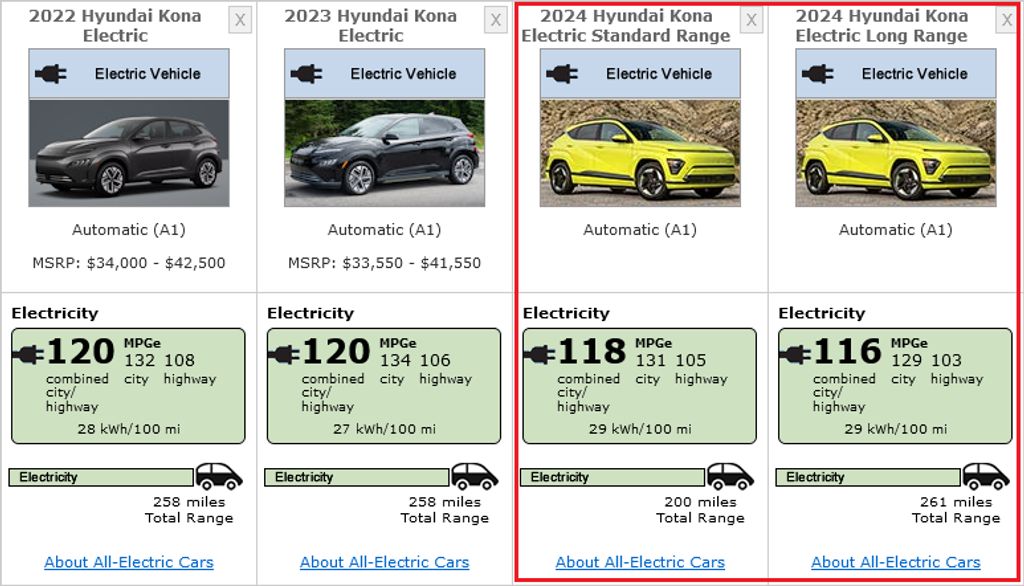The result is good, but only slightly better than in the case of the regular version.
The new, entry-level Hyundai Kona Electric version, equipped with a 48.6-kilowatt-hour battery, recently was listed on the U.S. Environmental Protection Agency (EPA) website, revealing its official range and energy consumption ratings.
The EPA Combined range is 200 miles, compared to 261 miles in the case of the regular version with a 64.8-kWh battery. The switch to a 33% higher battery capacity translates into a 30.5% higher range, indicating that the smaller version should be more efficient.
Hyundai Kona Electric lineup
In 2024, the Hyundai Kona Electric, for the very first time, is available in the U.S. with two battery sizes—48.6- and 64.8-kWh. Both models are among the most affordable ones with an effective price (MSRP + DST) of respectively $34,010 and $38,010.
It will be interesting to see whether the 200-mile Hyundai Kona Electric will attract customers looking for a basic EV. The difference between the two is $4,000 or over $65 per mile of additional range.

The 2024 Hyundai Kona Electric SE (48.6 kWh) with 17-inch wheels’ energy consumption, including charging losses, is estimated at 118 MPGe or about 286 watt-hours per mile (3.5 miles/kWh), one of the best results among EVs on the market.
Energy consumption is close to 2% lower than in the case of the Kona Electric with a 64.8-kWh battery. In other words, it seems that a smaller and lighter battery improves efficiency only slightly, although there are some other factors involved, too (lower-power electric motor).
Let’s note that the highway MPGe ratings are noticeably lower than the combined values. We estimate the EPA Highway range is about 20-30 miles (or over 10%) lower. However, this is only a rough estimate because the MPGe number includes charging losses.
| 2024 Hyundai Kona Electric SE (48.6 kWh) 17-in :: EPA Range rating by InsideEVs [Electric Vehicle 2-cycle label] |
|
| Combined City Highway |
200 miles (322 km) N/A N/A |
| EPA Energy consumption (including charging losses): | |
| Combined City Highway |
118 MPGe: 286 Wh/mi or 3.5 miles/kWh 131 MPGe: 257 Wh/mi or 3.9 miles/kWh 105 MPGe: 321 Wh/mi or 3.1 miles/kWh |
| 2024 Hyundai Kona Electric SEL & Limited 17-in :: EPA Range rating by InsideEVs [Electric Vehicle 2-cycle label] |
|
| Combined City Highway |
261 miles (420 km) N/A N/A |
| EPA Energy consumption (including charging losses): | |
| Combined City Highway |
116 MPGe: 291 Wh/mi or 3.4 miles/kWh 129 MPGe: 261 Wh/mi or 3.8 miles/kWh 103 MPGe: 327 Wh/mi or 3.1 miles/kWh |
In the past, the main competitor of the Hyundai Kona Electric was the Chevrolet Bolt EV/Bolt EUV duo (now retired).
| Model | Drive | Battery (kWh) |
EPA Range |
| 2024 Hyundai Kona Electric SE (48.6 kWh) 17-in | FWD | 48.6 | 200 mi |
| 2024 Hyundai Kona Electric SEL 17-in | FWD | 64.8 | 261 mi |
| 2024 Hyundai Kona Electric Limited 17-in | FWD | 64.8 | 261 mi |
Because the Hyundai Kona Electric is imported and not qualified for the $7,500 federal tax credit (the incentive might be available through leasing), its competitive position is weaker. The starting price for the entry-level version is $32,675 (plus a $1,335 destination charge). Some other considerably larger models can be purchased at a similar price.
| Model | Base Price | Dest. Charge | Tax Credit | Effective Price |
| 2024 Hyundai Kona Electric SE (48.6 kWh) 17-in | $32,675 | +$1,335 | N/A | $34,010 |
| 2024 Hyundai Kona Electric SEL 17-in | $36,675 | +$1,335 | N/A | $38,010 |
| 2024 Hyundai Kona Electric Limited 17-in | $41,045 | +$1,335 | N/A | $42,380 |
